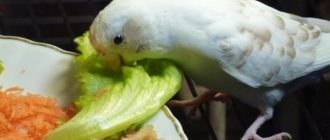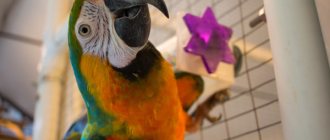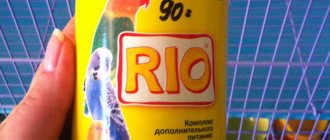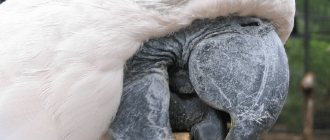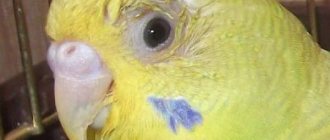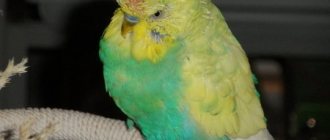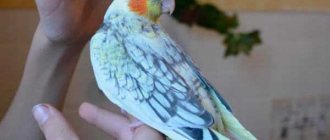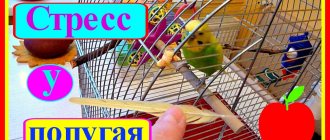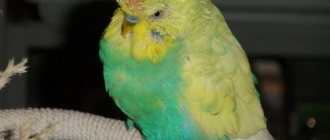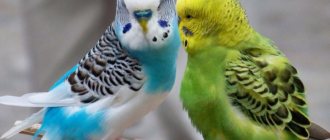Yawning is something of a mystery, and scientists still don't know the true cause of this phenomenon. Like most other vertebrates, parrots yawn frequently, and this happens for several reasons.
Parrots yawn when they are tired and also when they are happy or excited. Some parrots yawn after preening to stretch their muscles and straighten their throat. Yawning is highly contagious - when one parrot yawns, the rest are likely to follow. Parrots can also open and close their mouths several times in a row, as if yawning. This is a sign of a respiratory illness, bacterial infection, or regurgitation.
If your parrot opens his mouth frequently, check his sleeping area to ensure there is adequate shade and keep noise to a minimum. Likewise, if you suspect your parrot has a health problem, take him to the vet to find out what's causing his discomfort.
Why does a parrot open its beak
Very often, owners of different breeds of parrots witness how their parrot opens its beak and stretches its neck, and does this without a single sound. This behavior cannot be ignored. In most cases, such a scene is the result of natural causes and the fact that the bird is experiencing some discomfort, and sometimes it indicates illness.
Here are possible reasons why a parrot opens its beak without making a sound, as if yawning:
- He's feeling hot. In this case, the parrot can additionally spread its wings. The reason is high air temperature and low humidity - in nature, these birds live in the tropics. They try to inhale more air through their open beak. To help your pet, you need to ventilate the room and pour fresh water.
- There is no water at all in the cage. Another reason is that the pet asks for food.
- The parrot is scared or stressed. An open beak is a reaction to this condition, and can be caused by other pets, loud noises and new people.
- If the parrot is not alone in the cage, it may open its beak to attract the attention of its neighbor. For example, he asks to feed himself.
- Another common reason is that the bird has been poisoned by a chemical, smoke (tobacco is sufficient) or gasoline fumes, so it vomits. And through the open beak she tries to inhale more air. The consequences can be severe, so you need to consult a veterinarian.
There are other reasons for this behavior.
What makes parrots yawn?
One theory is that yawning "awakens" the brain , lowering its temperature. According to the second version, the body consumes less oxygen when sad or tired. Yawning helps bring more oxygen into the blood and remove excess carbon dioxide from it.
Parrots most often yawn for one of the following reasons:
Fatigue
Yawning is a sign of fatigue and changes within the body. Parrots yawn when tired, awakened and alert. Yawning can be a sign of lack of sleep, especially if your pet yawns over and over again. Other symptoms of sleep deprivation:
- feather plucking;
- aggression;
- lethargy;
- excessive screaming.
Photo: Shefalitayal
If you notice any of these symptoms, double check your parrot's sleeping area to make sure it is not too noisy and that it is dark enough at night. A bird needs 10-12 hours to sleep , and in unsuitable conditions it will not have enough time to rest. For sound sleep, parrots also need:
- a safe place where other pets cannot go;
- a sheet or blanket over the cage to provide sufficient darkness;
- bed for birds that do not like to sleep on a perch;
- birdhouse where birds can feel safe.
Providing these items, or at least those that are relevant to your parrot, will help him fall asleep peacefully every night and feel safe while resting.
Happiness
Yawning is a demonstration of happiness and affection. If you pet a bird and it yawns, it means it is enjoying the social interaction. Don't stop petting your pet right away, this is the perfect time to strengthen your bond. Likewise, petting and stroking can relax your parrot. As a result, he will start yawning because he will feel content.
Parrots may also yawn after receiving their favorite treat or playing. Being complex, intelligent creatures, they are very adept at expressing their feelings and do so in a variety of ways. Yawning is just one option. Other signs of happiness:
- singing;
- talk;
- whistling;
- chirping;
- tongue clicking;
- blush;
- rumbling;
- ruffling of feathers;
- stretching wings towards you.
These are signs that your parrot is comfortable around you. In this case, there is no need to worry about yawning.
Anxiety
Some parrots yawn to calm themselves down during times of stress or anxiety. If your pet shows signs of displeasure at the same time as yawning, then something is bothering him. It can be:
- poor living conditions;
- pesky pets such as cats and dogs;
- loud noise from the TV, radio or family members;
- aggressive cagemates ;
- poor quality food.
Signs of stress include:
- stress lines on feathers;
- loss of feathers;
- decreased appetite;
- weight loss;
- aggression;
- changes in vocalization;
- monotonous behavior.
To prevent your parrot from becoming restless, you need to give it more attention and improve its living conditions.
Preening
Some parrots yawn after preening their feathers. This is a natural process by which they put their feathers back in place, removing bacteria and dirt from them while distributing oils throughout the feathers. This keeps them clean and healthy.
Because parrots use their beaks to preen , they need to yawn afterwards to return the crop to its place. However, if your parrot constantly yawns after grooming himself, there may be something stuck in his crop.
Muscle stretching
Similar to preening, some parrots yawn to stretch their muscles, especially after a long sleep. This is normal - your bird is simply tidying up its crop in preparation for eating and drinking.
The only time you need to worry is if your parrot seems uncomfortable or in pain . This indicates a problem - most likely in the stomach, throat or esophagus.
Contagious example
Photo: Nikolai Alexandrovich
Yawning is contagious. In one study, budgerigars were placed in pairs in adjacent cages without a visual barrier. In another study, the birds were shown a video of other budgerigars yawning. Scientists found that budgerigars yawned three times more often when they could see each other, and twice as often when they watched a video of their fellow budgies yawning.
Removing lint from the throat
All parrots are very clean, and therefore regularly clean their wings with their beaks. This happens especially often during the molting period. As a result, lint may get lodged in your throat. For this reason, the pet opens its beak wide and stretches its neck, as it tries to get rid of the discomfort that has arisen.
In this case, the parrot will cope with the problem itself. You should only intervene in an exceptional case: if all the bird’s attempts to clear its throat end in failure.
Moving food stuck in the throat
It happens that a bird comes across a large piece of product in the food. Food gets stuck in the throat, and the pet tries with all its might to swallow it. This is the second common reason that a parrot sits with its neck extended forward and its beak open.
At this point, it is important to check whether there is water in the drinking bowl. Drinking will help the parrot cope with the task on its own. But there are no known cases where a pet died from choking or choking on a small piece of food.
Aspergillosis
Aspergillosis is a respiratory disease caused by a group of molds that affects the respiratory system. Mushrooms choose the lungs as their habitat; they can only be identified using x-rays. Concomitant symptoms of the disease, in addition to difficulty breathing with an open beak, are fever, cough with blood discharge, refusal to eat, lethargy, drowsiness, loss of voice, severe respiratory failure.
The danger of fungal infection lies in its ubiquity. It is enough to place a bird with a weakened immune system in a very dusty, unventilated room or feed it moldy food, and fungal spores will quickly settle in its lungs. Effective treatment is possible only in the early stages of identifying the disease. In its advanced state, aspergillosis leads to the death of the bird. The treatment is very complex and can only be prescribed by a doctor. The weakened immunity of sick birds cannot always withstand it.
Beak deformation
The beak of parrots performs many functions. Birds take food with them, get seeds from plants and berries, crack nuts, try unfamiliar objects, build a nest, clean feathers and even defend themselves. By nature, it is very strong, since it is based on calcium. But sometimes, due to improper feeding, the tissues of the beak soften and it changes shape. This affects the general condition of the pet, since the parrot cannot eat and breathe normally.
It is not difficult to correct the situation and return the beak to its previous shape: food rich in calcium should be included in the bird’s diet.
Respiratory poisoning
Also, the reason parrots often open the key can be the presence of toxic substances in the air, for example, cigarette smoke, kerosene from a heater, or detergents.
The parrot begins to feel sick, and there is a clear lack of air. Treatment of the consequences is usually difficult.
Often a bird dies if veterinary care is not provided in time.
Trying to speak
In most cases, parrot owners get these birds in the hope that they will start talking. That’s why they conduct classes every day and play recordings for the pets. In this case, the reason why a cockatoo, cockatiel or budgerigar opens its mouth or opens it slightly as if talking is understandable.
He tries to repeat sounds or words, but so far without success. The same thing sometimes occurs when the TV is loud in the room or music is playing. In this case, the pet will probably start talking soon.
Certain Behaviors
Budgerigars have a very changeable character and their own perception of the world around them. They can have fun and sing, and a minute later they will get ruffled and grumble. Some birds have an easygoing disposition and therefore make contact quite easily, others behave quite aggressively, others are cowardly and can constantly hide from their fellow birds or people.
The owner must understand the behavior of his pet in order to be able to understand in time when everything is fine with him and when something is wrong. Of course, you won’t be able to change the character of the “wavy dog,” but you can change his attitude towards his owner personally. Having observed these birds for a long time, one can come to the conclusion that their habits are divided into two types:
- biological;
- external.
Let's take a closer look at each type of budgerigar behavior.
Tracheal mite
This is already a fairly serious reason that the parrot yawns, constantly or quite often. He also loses his appetite and becomes lethargic. If these symptoms occur, you should consult a specialist. After testing, he will prescribe treatment, which usually includes taking Ivermectin, Permethrin or Dectomax. The dosage is selected by the veterinarian depending on the complexity of the case.
This issue needs to be taken seriously, since the tracheal mite is a parasite that often causes the death of a bird. It multiplies very quickly, but only a small part of the mites is excreted from the body along with mucus when sneezing and coughing, as well as with droppings.
In addition to treatment, it will be necessary to completely disinfect the cage and its accessories (it is better to throw away wooden objects, since parasites live on them for a very long time).
Sinusitis
With this disease, inflammation of the nasal mucosa is accompanied by purulent discharge. The parrot has difficulty breathing, it is accompanied by wheezing, the area around the nose is swollen, the bird looks depressed and weakened.
The causative agents of the disease are often infections - both bacterial and viral. The occurrence of sinusitis in a parrot can be caused by:
- insufficient vitamin A content in the body;
- a wound received during a flight.
The advanced stage of the disease is treated through surgery.
Prevention
In order to avoid serious respiratory diseases, it is necessary to monitor the living conditions of the parrot. Hypothermia, drafts and outdoor swimming should not be allowed.
The room where the bird's cage is located should not be damp. A prerequisite is a sufficient level of lighting. Do not wash or treat the cage with aggressive chemicals, smoke near the bird, or use aggressively scented perfumes or aerosol air fresheners. Any colds must be treated promptly. Prevention of stroke comes down to adequate physical activity for the bird, but remember, the parrot cannot be prevented from flying.
The parrot is breathing heavily

